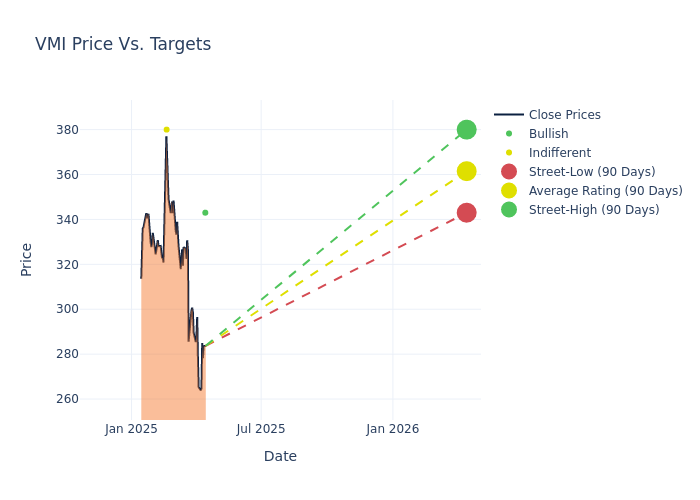Assessing Valmont Industries: Insights From 4 Financial Analysts
Providing a diverse range of perspectives from bullish to bearish, 4 analysts have published ratings on Valmont Industries (NYSE:VMI) in the last three months.
The table below offers a condensed view of their recent ratings, showcasing the changing sentiments over the past 30 days and comparing them to the preceding months.
| Bullish | Somewhat Bullish | Indifferent | Somewhat Bearish | Bearish | |
|---|---|---|---|---|---|
| Total Ratings | 3 | 0 | 1 | 0 | 0 |
| Last 30D | 1 | 0 | 0 | 0 | 0 |
| 1M Ago | 0 | 0 | 0 | 0 | 0 |
| 2M Ago | 1 | 0 | 1 | 0 | 0 |
| 3M Ago | 1 | 0 | 0 | 0 | 0 |
Analysts provide deeper insights through their assessments of 12-month price targets, revealing an average target of $383.75, a high estimate of $425.00, and a low estimate of $343.00. A negative shift in sentiment is evident as analysts have decreased the average price target by 2.48%.

Exploring Analyst Ratings: An In-Depth Overview
The analysis of recent analyst actions sheds light on the perception of Valmont Industries by financial experts. The following summary presents key analysts, their recent evaluations, and adjustments to ratings and price targets.
| Analyst | Analyst Firm | Action Taken | Rating |Current Price Target| Prior Price Target | |--------------------|--------------------|---------------|---------------|--------------------|--------------------| |Nathan Jones |Stifel |Lowers |Buy | $343.00|$425.00 | |Brent Thielman |DA Davidson |Maintains |Neutral | $380.00|$380.00 | |Nathan Jones |Stifel |Raises |Buy | $425.00|$387.00 | |Nathan Jones |Stifel |Raises |Buy | $387.00|$382.00 |
Key Insights:
- Action Taken: Responding to changing market dynamics and company performance, analysts update their recommendations. Whether they 'Maintain', 'Raise', or 'Lower' their stance, it signifies their response to recent developments related to Valmont Industries. This offers insight into analysts' perspectives on the current state of the company.
- Rating: Offering insights into predictions, analysts assign qualitative values, from 'Outperform' to 'Underperform'. These ratings convey expectations for the relative performance of Valmont Industries compared to the broader market.
- Price Targets: Analysts explore the dynamics of price targets, providing estimates for the future value of Valmont Industries's stock. This examination reveals shifts in analysts' expectations over time.
Understanding these analyst evaluations alongside key financial indicators can offer valuable insights into Valmont Industries's market standing. Stay informed and make well-considered decisions with our Ratings Table.
Stay up to date on Valmont Industries analyst ratings.
Unveiling the Story Behind Valmont Industries
Valmont Industries Inc, along with its subsidiaries, operates as a manufacturer of products and services for infrastructure and agriculture markets. Its reportable segments are Infrastructure and Agriculture. The company generates maximum revenue from the Infrastructure segment, which includes the manufacturing and distribution of products and solutions to serve the infrastructure markets of utility, solar, lighting and transportation, and telecommunications, along with coatings services to protect metal products. The Agriculture segment provides irrigation equipment components, including aftermarket parts and tubular products, and technology solutions for precision agriculture. Geographically, it derives key revenue from the United States, followed by Australia, Brazil, and other regions.
Breaking Down Valmont Industries's Financial Performance
Market Capitalization: With restricted market capitalization, the company is positioned below industry averages. This reflects a smaller scale relative to peers.
Revenue Growth: Valmont Industries's remarkable performance in 3M is evident. As of 31 December, 2024, the company achieved an impressive revenue growth rate of 2.14%. This signifies a substantial increase in the company's top-line earnings. As compared to competitors, the company encountered difficulties, with a growth rate lower than the average among peers in the Industrials sector.
Net Margin: The company's net margin is below industry benchmarks, signaling potential difficulties in achieving strong profitability. With a net margin of 7.49%, the company may need to address challenges in effective cost control.
Return on Equity (ROE): Valmont Industries's ROE is below industry averages, indicating potential challenges in efficiently utilizing equity capital. With an ROE of 5.04%, the company may face hurdles in achieving optimal financial returns.
Return on Assets (ROA): Valmont Industries's ROA is below industry averages, indicating potential challenges in efficiently utilizing assets. With an ROA of 2.27%, the company may face hurdles in achieving optimal financial returns.
Debt Management: With a below-average debt-to-equity ratio of 0.56, Valmont Industries adopts a prudent financial strategy, indicating a balanced approach to debt management.
The Significance of Analyst Ratings Explained
Ratings come from analysts, or specialists within banking and financial systems that report for specific stocks or defined sectors (typically once per quarter for each stock). Analysts usually derive their information from company conference calls and meetings, financial statements, and conversations with important insiders to reach their decisions.
Analysts may enhance their evaluations by incorporating forecasts for metrics like growth estimates, earnings, and revenue, delivering additional guidance to investors. It is vital to acknowledge that, although experts in stocks and sectors, analysts are human and express their opinions when providing insights.
Which Stocks Are Analysts Recommending Now?
Benzinga Edge gives you instant access to all major analyst upgrades, downgrades, and price targets. Sort by accuracy, upside potential, and more. Click here to stay ahead of the market.
This article was generated by Benzinga's automated content engine and reviewed by an editor.
 Wall Street Journal
Wall Street Journal